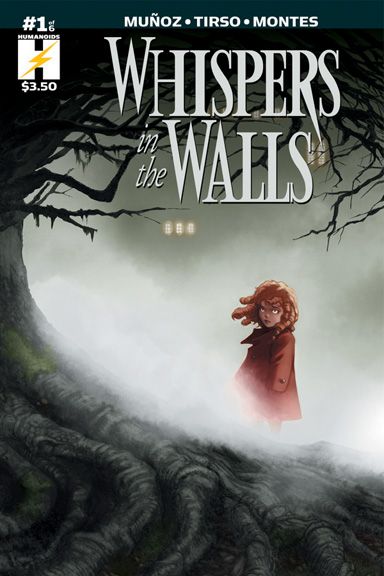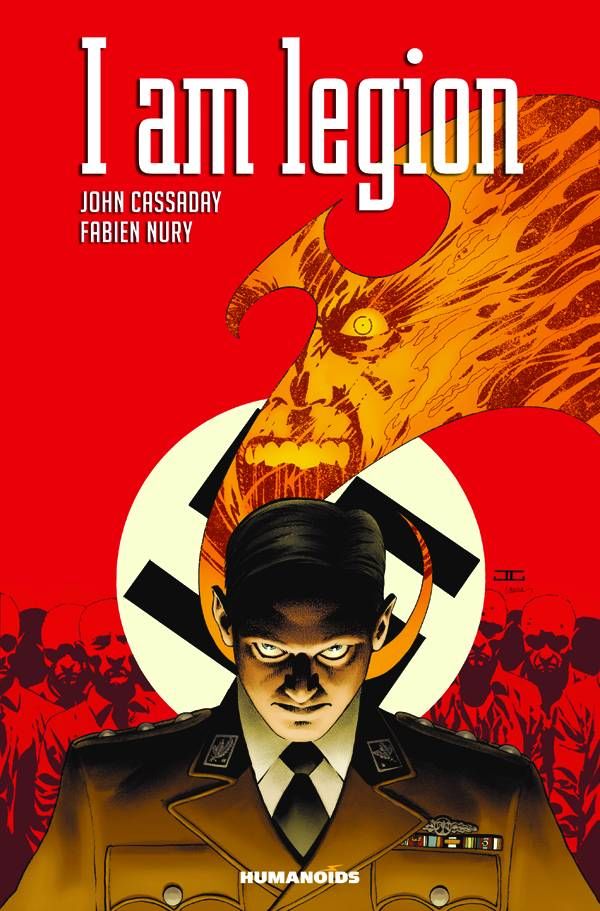I am very behind. Bob Silva at Humanoids was kind enough to send me these two months ago and I read them soon after they arrived, but kept pushing writing a review back. No good excuse, just a combination of laziness, other stuff to do, and life being busy. But, no more! These reviews get written now! Read what I have to say below the cut.
Whispers in the Walls #1-2. Written by David Muñoz. Drawn by Tirso.
I understand beginning the new stage of Humanoids's North American publishing with I Am Legion in hardcover, but Whispers in the Walls as one of the 'launch books' mystifies me a little. That's not a statement about the comic's quality, more a musing about how, until these books landed in my mailbox, I hadn't heard of them besides Bob mentioning them in an e-mail. Not a book I've heard about before, but that sort of tells you something about Humanoids: they publish what they think is good, not what just what they think will have immediate name recognition. I like that. If anything, choosing a book that I was unfamiliar with as one of their first in their newest incarnation sells it better. It must be good if they're beginning with it out of the dozens (if not hundreds) of available options.
But, that's not necessarily the case.
Whispers in the Walls is a cute book, but it didn't really land with me. The plot is pretty basic: in 1949 Czechoslovakia, there's a hospital where some kids are being kept for reasons they don't understand. They're becoming monsters (vampires?) and the government wants to figure out how to stop it. Lots of mysterious behaviour and the kids learning to work together and things going wrong. I can see the appeal of the story, but it's not for me. I can appreciate the things that the comics do right and, still, they're not for me.
Tirso's art, for example, is done with great skill, but his cartoony style doesn't resonate with me. For some reason, it has a manga/Asian look (to me at least) and that runs counter to the setting. It seems like a strange influence to draw upon. He uses the page to his full advantage, filling each one with tons of panels -- and his storytelling and character work is strong. He builds tension and depicts action with skill. But, on a stylistic level, I don't like the art. The lead girl looks weird to me.
I don't have a lot to say about this comic, because, as I said, I can see why others would like it, but it does nothing for me. I was never engaged with the characters or the story. I've seen that Greg has been reading it (but didn't read his thoughts because I usually avoid what others say about something I'm reviewing). I assume he's enjoying it or else he wouldn't be buying it still. Glad I got a chance to try these first two issues out, though.
***
I am Legion. Written by Fabien Nury. Drawn by John Cassaday.
This is, what, the third or fourth time this material has been published in North America (whether the previous releases were complete or not, I don't know)? I can understand why Humanoids would keep pushing a John Cassaday-drawn series at the beginning of a new publishing attempt/phase. He's a very well known artist and the prospect of interior art that a lot of readers haven't seen is an alluring one. He even gets top billing on the cover. And that, too, makes sense.
The hardcover presentation is good. The book is in the European dimensions/size and has all three albums of I am Legion with some bonus art at the end. It's nice glossy paper to show off Cassaday and Laura Martin's art. For thirty bucks, it's what you'd want.
Like Whispers in the Walls, the story here revolves around vampires. That was amusing to me. This one takes place during World War II instead of four years later and is a little too complicated for its own good. There are numerous plot threads that build separately before coming together and they don't all cohere cleanly. The plot is built around two main characters: both entities that can travel from one body to another via blood, even inhabiting more than one body at once. One is in England and trying to track the other; the other is in a little girl in Romania that the Nazis are experimenting on and trying to develop as a weapon. Surrounding this are Nazi resistors, a British investigation into a murder, secret missions, Nazi politics, and it becomes a bit much. Not everything matters in a big way by the end where the inflated plots deflate quickly to easy to understand/remember bits.
Nury is good at giving quick ideas of who characters are, what they want, and how they act. Stanley, the head of a team of investigators, is one of the more interesting characters. His wife is newly dead, he's having sex with a woman on his team, and he's pursuing a murder case with supernatural elements and hints of corruption into high levels of the British government and industry. He's both respected and looked down upon, and always seems two minutes away from losing his shit entirely. An odd fellow to make one of the protagonists, but he's also damn good at his job, making him easy to get behind.
The battle of wills between two competing Nazis is another positive of the writing. Competing divisions and schemes, including one to subvert/kill Hitler, and various behind-the-scenes moves. I love that sort of thing and it's oddly entertaining when you're watching it happen to Nazis. There's almost something absurd about the idea of this abstract evil organisation having dissent and behind-the-scenes politics and such. You always think of it as one large machine moving together, everyone saying the same thing, thinking the same thing -- and that's obviously not how it happened. But, that's how it seems, because the idea of the Nazis is so large and abstract that thinking of any as people with the regular ambitions and desires doesn't always happen naturally.
The take on vampires and how they exist is a novel one. The key here is still blood, but not the typical vampire behaviour with the biting and the bats and the garlic and sunlight... this one focuses on the blood and the 'mind control' aspect. The only sign that someone has been infected/taken over is a mark on the back of their neck. This type of vampire is more frightening because of their invisibility and ability to simply become someone else. More a virus -- a living virus -- than anything else.
But, Nury's writing does have some big flaws. The overly (and somewhat unnecessarily) complex nature of the plot. Pages upon pages loaded with dialogue that never seems to end. This often plants small seeds that come to fruition later on, but not always in a way that needed so much time and exposition early on. A streamlining of the plots and keeping things to the essentials would be more beneficial. With so many plots that aren't shown to be related until halfway through the story (at least) and so many characters, the story is a bit of a slog to get through at times.
This style of writing affects the art to a degree. This is the first comic I've seen by John Cassaday that has zero splash pages. In fact, the least number of panels on a page is three and that happens once. The minimum most of the time is five. Now, the pages are larger and I don't think that the constant use of splashes or two-panel pages that Cassaday usually relies upon is the best approach, but Cassaday's art is somewhat buried at times. He gets to show off his character skills in depicting the extensive conversations with brief action scenes peppered in. With so many pages following a similar look, the rhythm of the comic becomes a little dull. Cassaday is often at his best when he can do a solid rhythm and, then, BAM! A big gorgeous picture that stops you dead. There aren't too many deadstop pages. Lots of good craftsmanship by Cassaday. Good storytelling as he tries every trick to make dialogue scenes look interesting.
Cassaday seems interested in the smaller moments here, too. His action scenes purposefully use lots of smaller panels, showing minute details. I don't know if Fury wrote in full script or Cassaday had some leeway, but I do think there's a possibility that Cassaday purposefully went in another direction to really challenge himself. Not everything works. While his line work and actual drawings are attractive, his storytelling is bland, especially early on. He doesn't seem to know how to do these pages of dialogue with eight or nine panels. He reuses uninteresting shots, draws a lot of straight-on medium shots, and struggles somewhat. He gets better as he goes and that's probably the most interesting thing about the book: watching as Cassaday learns how to draw pages with seven or more panels and make them as visually arresting as possible. At first, he doesn't stray too much from grid-like layouts, but he eventually begins to break borders or use illustrations that aren't in a rectangular panel border at all. He loosens up and plays with the pages more. It's like, at first, he sticks to an idea of what a Franco-Belgium comic page should look like and, gradually, departs from that concept when it seems appropriate. If anything, I am Legion makes me miss Cassaday drawing comics. His cover work is fine, but this guy could draw the hell out of a comic and I'm wondering what he could do with a writer like Alan Moore or maybe Grant Morrison.
I don't have much to say about Laura Martin's colours. She and Cassaday are a pretty harmonious team. Martin uses computer colors and layers effectively, giving each scene its own feeling and tone through the colours. She doesn't use a strict filter, but the colour cues do help establish where each scene is taking place since the book jumps around a lot.
Not a perfect book, I am Legion is overwritten, but it's also a clever and often engaging story. If you're a fan of John Cassaday's art, this is definitely worth picking up to see him focus on panel-to-panel storytelling and, then, how to maintain that storytelling while creating less grid-like page layouts. Definitely not decompressed storytelling.
I'm looking forward to what else this new iteration of the North American branch of Humanoids puts out.



